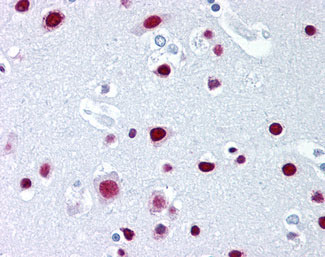SAFB1 / SAFB Antibody (aa345-357, clone 6F7)
Mouse Monoclonal Antibody
- SPECIFICATION
- CITATIONS
- PROTOCOLS
- BACKGROUND

Application
| WB, IHC-P, IF, IP |
|---|---|
| Primary Accession | Q15424 |
| Reactivity | Human, Monkey |
| Host | Mouse |
| Clonality | Monoclonal |
| Clone Names | 6F7 |
| Calculated MW | 103kDa |
| Dilution | IHC-P (5 µg/ml) |
| Gene ID | 6294 |
|---|---|
| Other Names | Scaffold attachment factor B1, SAF-B, SAF-B1, HSP27 estrogen response element-TATA box-binding protein, HSP27 ERE-TATA-binding protein, SAFB, HAP, HET, SAFB1 |
| Target/Specificity | A synthetic peptide corresponding to amino acids 345-357 (PEARDSKEDGRKF) of the human HET protein. |
| Reconstitution & Storage | Short term 4°C, long term aliquot and store at -20°C, avoid freeze thaw cycles. |
| Precautions | SAFB1 / SAFB Antibody (aa345-357, clone 6F7) is for research use only and not for use in diagnostic or therapeutic procedures. |
| Name | SAFB |
|---|---|
| Synonyms | HAP, HET, SAFB1 |
| Function | Binds to scaffold/matrix attachment region (S/MAR) DNA and forms a molecular assembly point to allow the formation of a 'transcriptosomal' complex (consisting of SR proteins and RNA polymerase II) coupling transcription and RNA processing (PubMed:9671816). Functions as an estrogen receptor corepressor and can also bind to the HSP27 promoter and decrease its transcription (PubMed:12660241). Thereby acts as a negative regulator of cell proliferation (PubMed:12660241). When associated with RBMX, binds to and stimulates transcription from the SREBF1 promoter (By similarity). |
| Cellular Location | Nucleus |
| Tissue Location | Ubiquitous. Expressed at high levels in the CNS and at low levels in the liver. Expressed in a wide number of breast cancer cell lines |

Thousands of laboratories across the world have published research that depended on the performance of antibodies from Abcepta to advance their research. Check out links to articles that cite our products in major peer-reviewed journals, organized by research category.
info@abcepta.com, and receive a free "I Love Antibodies" mug.
Provided below are standard protocols that you may find useful for product applications.
Background
Binds to scaffold/matrix attachment region (S/MAR) DNA and forms a molecular assembly point to allow the formation of a 'transcriptosomal' complex (consisting of SR proteins and RNA polymerase II) coupling transcription and RNA processing (By similarity). Can function as an estrogen receptor corepressor and can also bind to the HSP27 promoter and decrease its transcription. When associated with RBMX, binds to and stimulates transcription from the SREBF1 promoter (By similarity). Can inhibit cell proliferation.
References
Oesterreich S.,et al.J. Cell. Biochem. 67:275-286(1997).
Ota T.,et al.Nat. Genet. 36:40-45(2004).
Grimwood J.,et al.Nature 428:529-535(2004).
Totoki Y.,et al.Submitted (MAR-2005) to the EMBL/GenBank/DDBJ databases.
Bienvenut W.V.,et al.Submitted (JUL-2009) to UniProtKB.
If you have used an Abcepta product and would like to share how it has performed, please click on the "Submit Review" button and provide the requested information. Our staff will examine and post your review and contact you if needed.
If you have any additional inquiries please email technical services at tech@abcepta.com.













 Foundational characteristics of cancer include proliferation, angiogenesis, migration, evasion of apoptosis, and cellular immortality. Find key markers for these cellular processes and antibodies to detect them.
Foundational characteristics of cancer include proliferation, angiogenesis, migration, evasion of apoptosis, and cellular immortality. Find key markers for these cellular processes and antibodies to detect them. The SUMOplot™ Analysis Program predicts and scores sumoylation sites in your protein. SUMOylation is a post-translational modification involved in various cellular processes, such as nuclear-cytosolic transport, transcriptional regulation, apoptosis, protein stability, response to stress, and progression through the cell cycle.
The SUMOplot™ Analysis Program predicts and scores sumoylation sites in your protein. SUMOylation is a post-translational modification involved in various cellular processes, such as nuclear-cytosolic transport, transcriptional regulation, apoptosis, protein stability, response to stress, and progression through the cell cycle. The Autophagy Receptor Motif Plotter predicts and scores autophagy receptor binding sites in your protein. Identifying proteins connected to this pathway is critical to understanding the role of autophagy in physiological as well as pathological processes such as development, differentiation, neurodegenerative diseases, stress, infection, and cancer.
The Autophagy Receptor Motif Plotter predicts and scores autophagy receptor binding sites in your protein. Identifying proteins connected to this pathway is critical to understanding the role of autophagy in physiological as well as pathological processes such as development, differentiation, neurodegenerative diseases, stress, infection, and cancer.


